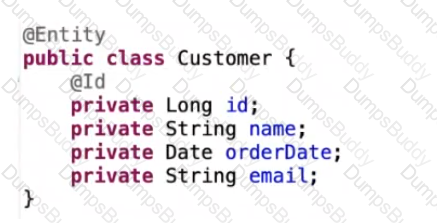Refer to the exhibit.

How can a response status code be set for No Content (204)? (Choose the best answer.)
Which statement describes the @AfterReturning advice type? (Choose the best answer.)
Which two statements are true regarding storing user details in Spring Security? (Choose two.)
If a class is annotated with @Component, what should be done to have Spring automatically detect the annotated class and load it as a bean? (Choose the best answer.)
Refer to the exhibit.

Which two methods will be implemented at runtime if declared in a Spring Data JPA Repository? (Choose two.)
Which statement describes the propagation behavior of Propagation.REQUIRES_NEW annotation? (Choose the best answer.)
Which two statements are correct regarding Spring Boot auto-configuration customization? (Choose two.)
Which two statements are correct regarding the differences between @ConfigurationProperties and @Value? (Choose two.)
Which option is true about use of mocks in a Spring Boot web slice test? (Choose the best answer.)
Refer to the exhibit.

Which option is a valid way to retrieve the account id? (Choose the best answer.)
Refer to the exhibit.

How can a Spring Bean be created from this LegacySingleton class?
Which two annotations are meta-annotations on the @SpringBootApplication composed annotation? (Choose two.)
Which two options are application slices that can be tested with Spring Boot Testing? (Choose two.)